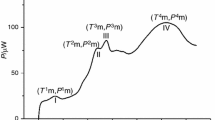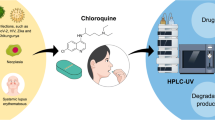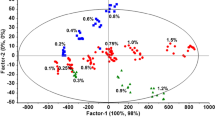Abstract
Chinese Medicine Injections (CMIs) are powerful preparations, but adverse drug reactions can hardly be avoided. Incorrect drug combination is a major cause. Recently, insoluble particulate matter test, pH measurement, and high performance liquid chromatography (HPLC) fingerprint have been recommended as potential strategies for prediction of drug-incompatible reactions. However, these methods were complex to manipulate, subjective to judge, or were of poor relevance and low sensitivity. In this study, a novel application for the detection of compatibility of combination of CMIs based on isothermal titration calorimetry (ITC) has been proposed. Qingkailing Injection (QKL) was selected as a representative drug to blend with Potassium Chloride Injection (KCl) and Calcium Chloride Injection (CaCl2). The type of reactions between them was intuitively manifested by the thermodynamic parameters including Gibbs free energy change (ΔG), enthalpy change (ΔH), and entropy change (ΔS). The results indicated that when QKL mixed with CaCl2, ΔG < 0, and |ΔH| > T|ΔS|, which meant chemical changes happened between them and ADRs might happen in clinic. On the contrary, the reactions between QKL and KCl existed solely as physical processes, indicating that it was relatively safe. Meanwhile, HPLC fingerprint was also applied, but no significant difference was found. It is hard to distinguish whether incompatible reactions have happened during HPLC. The study suggested that with the advantages of convenience, sensitivity, and reliability, ITC could serve as an essential tool in the detection of incompatible reactions of drug combination. The described method could be used for early prediction of adverse drug reactions, which would be helpful to ensure the rationality of drug combination.



Similar content being viewed by others
References
Li WL, Xing LH, Fang LM, Wang J, Qu HB. Application of near infrared spectroscopy for rapid analysis of intermediates of Tanreqing injection. J Pharm Biomed. 2010;53:350–8.
Zhang ZY, Chen M, Chen J, Padval MV, Kansra VV. Biotransformation and in vitro assessment of metabolism-associated drug–drug interaction for CRx-102: a novel combination drug candidate. J Pharm Biomed. 2009;50:200–9.
Ji KM, Chen JJ, Li M, Liu ZG, Xia LX, Wang CB, Zhan ZK, Wu XL. Comments on serious anaphylaxis caused by nine Chinese herbal injections used to treat common colds and upper respiratory tract infections. Regul Toxicol Pharm. 2009;55:134–8.
Yakuji Nippo Ltd. Japanese Pharmacopeia. 16th ed. Ministry of Health, Labour and Welfare, Tokyo, Japan; 2011.
Jiang Y, David B, Tu PF, Barbin Y. Recent analytical approaches in quality control of traditional Chinese medicines: a review. Anal Chim Acta. 2010;657:9–18.
Ren YS, Zhang P, Yan D, Wang JB, Du XX, Xiao XH. A strategy for the detection of quality fluctuation of a Chinese herbal injection based on chemical fingerprinting combined with biological fingerprinting. J Pharm Biomed. 2011;56:436–42.
Doyle ML. Characterization of binding interactions by isothermal titration calorimetry. Curr Opin Biotech. 1997;8:31–5.
Zeiss D, Annette BB. Isothermal titration calorimetry (ITC) method to study drug/ion exchanger interaction. J Therm Anal Calorim. 2006;83:309–12.
Burguete AS, Fen TD, Brunger AT, Pfeffer SR. Rab and Arl GTPase family members cooperate in the localization of the golgin GCC185. Cell. 2008;132:286–98.
Wang ZX, Song JK, Milne TA, Wang GG, Li HT, Allis CD, Patel DJ. Pro isomerization in MLL1 PHD3-bromo cassette connects H3K4me readout to CyP33 and HDAC-mediated repression. Cell. 2010;141:1183–94.
Filippakopoulos P, Qi J, Picaud S, Shen Y, Smith WB, Fedorov O, Morse EM, Keates T. Selective inhibition of BET bromodomains. Nature. 2010;468:1067–73.
Nicodeme E, Jeffrey KL, Schaefer U, Beinke S, Dewell S, Chung CW, Chandwani R, Marazzi I, Wilson P. Suppression of inflammation by a synthetic histone mimic. Nature. 2010;468:1119–23.
Lopez MM, Chin DH, Baldwin RL, Makhatadze GI. The enthalpy of the alanine peptide helix measured by isothermal titration calorimetry using metal binding to induce helix formation. PANS. 2002;99:1298–302.
Wu XL, Yang ZY, Li YX, Hogerkorp CM, Schief WR, Seaman MS, Zhou TQ, Schmidt SD, Wu L. Rational design of envelope identifies broadly neutralizing human monoclonal antibodies to HIV-1. Science. 2010;329:856–61.
Małgorzata WR, Paweł G. Isothermal titration calorimetry (ITC) study of natural cyclodextrins inclusion complexes with drugs. J Therm Anal Calorim. 2012. doi:10.1007/s10973-012-2251-4.
Alan C. Microcalorimetry of heat capacity and volumetric changes in biomolecular interactions: the link to solvation? J Therm Anal Calorim. 2011;104:69–73.
Wyrzykowski D, Zarzeczańska D, Jacewicz D, Chmurzyński D. Investigation of copper(II) complexation by glycylglycine using isothermal titration calorimetry. J Therm Anal Calorim. 2011;105:1043–7.
Lv L, Liu Y, Shi HF, Dong Q, Ling QK. Injection attenuates apoptosis and neurologic deficits in a rat model of intracerebral hemorrhage. J Ethnopharmacol. 2009;125:269–73.
Yan SK, Xin WF, Luo GA, Wang YM, Cheng YY. An approach to develop two-dimensional fingerprint for the quality control of Qingkailing Injection by high-performance liquid chromatography with diode array detection. J Chromatogr A. 2005;1090:90–7.
Zhang HY, Hua P, Luo GA, Liang QL, Wang YL, Yan SK, Wang YM. Screening and identification of multi-component in Qingkailing injection using combination of liquid chromatography/time-of-flight mass spectrometry and liquid chromatography/ion trap mass spectrometry. Anal Chim Acta. 2006;577:190–200.
Acknowledgements
The authors gratefully acknowledge the supports from the National Natural Science Foundation of China (30873385, 81173542), Beijing Natural Science Foundation (7112128), and the Open Research Fund of State Key Laboratory Breeding Base of Systematic Research, Development and Utilization of Chinese Medicinal Resources.
Author information
Authors and Affiliations
Corresponding author
Additional information
Longhu Chen and Lingling Qiu contributed equally to this work.
Rights and permissions
About this article
Cite this article
Chen, L., Qiu, L., Yan, D. et al. Isothermal titration calorimetry vs. high performance liquid chromatography fingerprint. J Therm Anal Calorim 111, 965–970 (2013). https://doi.org/10.1007/s10973-012-2456-6
Received:
Accepted:
Published:
Issue Date:
DOI: https://doi.org/10.1007/s10973-012-2456-6




